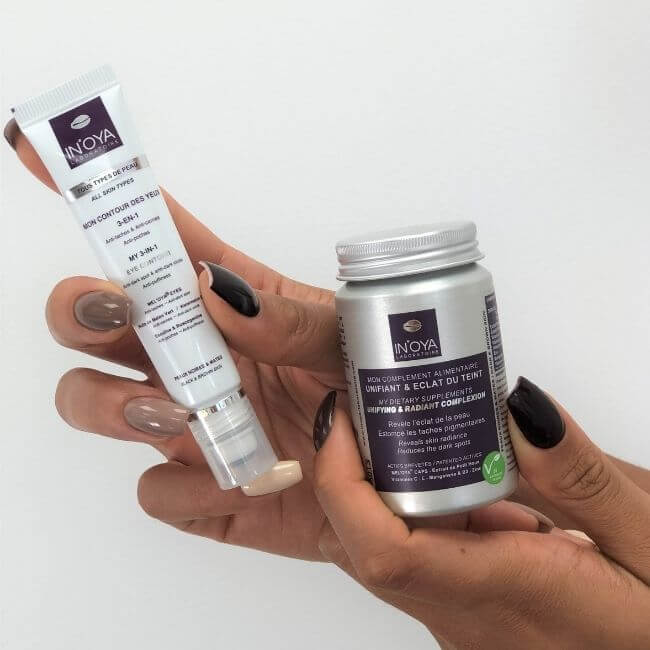 Would you be able to differentiate these two sentences : " I have blue dark circles, because I lack sleep " and " I have black spots under my eyes " ? Indeed, they are two very distinct skin problems. The first is related to an unhealthy lifestyle (lack of sleep, tobacco, alcohol, etc.) and the second to hyperpigmentation of the skin.
Would you be able to differentiate these two sentences : " I have blue dark circles, because I lack sleep " and " I have black spots under my eyes " ? Indeed, they are two very distinct skin problems. The first is related to an unhealthy lifestyle (lack of sleep, tobacco, alcohol, etc.) and the second to hyperpigmentation of the skin.
It is not trivial to note that it is pigmented skin and mainly black skin that mainly suffer from these hyperpigmentation spots called pigmentary dark circles. It is therefore important to understand how these brown dark circles appear to determine how to treat them effectively.
What is a ring ?
Commonly, a dark circle is called a change in the natural shade of the skin under the eye. This can be accentuated by a shadow effect caused by the creation of a hollow under this same area or conversely, a swelling (a pocket). Scientifically, a ring is called : a peri-orbital hyperpigmentation.
A classification was subsequently carried out in order to distinguish the different types of dark circles : the pigment ring of brown / black color, the vascular ring of blue / purple color, the hollow ring which brings a shadow effect to the eye contour or a mixed ring which is the association of two types of dark circles. Depending on their characteristics, each can be specifically associated with a skin phototype.
Know the different types of dark circles on black skin
The pigment ring
Black skin is mainly affected by the appearance of dark circles under the eyes. This skin color more intense than their natural complexion appears mainly on the lower and/ or upper eyelid but it can also extend to the malar regions, temporal and lateral nasal root.
With a prevalence of 30.76% and benign in nature, these dark circles are perceived as unsightly and are considered complex because they provide a tired look to the patient. They are thus a reason for dermatological consultations.
These " dark circles " are defined as " pigment spots" because they are both caused by hyperpigmentation of the skin caused by an overproduction of melanin pigments (eumelanins, brown pigments in black skin).
The hollow (structural) ring
It is possible to see in black, matte and mixed skin the appearance of a groove under the lower eyelid. This hollow circle is mainly caused by the melting of the fatty tissue under the eye. It appears mainly with age because it is related to the natural aging of the skin but it is possible to perceive it younger by its also hereditary character.
Clinically, it differs from pigmentary dark circles, as it appears in the form of structural shadows formed by the anatomical contours of the face.
The type of mixed dark circles (PS)
Among the different types of mixed dark circles, the pigment-structural mixed ring circle is most common in black skin. It is qualified by a dark eye contour that is accentuated by a hollow of the lower eyelid. In other words, it is a hyperpigmentation of the skin associated with fat loss.
What causes dark circles under the eyes?
Genetics / Heredity
Dark circles are called constitutional because they are frequently seen in several members of the same family. However, genetic conditions are not necessarily congenital (present at birth). The genotype is fixed at conception, but the phenotype can manifest itself only at puberty or adult life, the most common, between 16-25 years. Little scientific data exists to specifically understand which gene or allele is involved to cause the appearance of these pigment rings.
Hormonal hyperpigmentation
- Stress
During a period of stress, the adrenal gland will secrete a significant amount of cortisol (a hormone that allows the body to resist stress), but when this period of stress is prolonged, the adrenal gland becomes depleted, causing hormonal imbalance.
The hormone ACTH will then increase in order to stimulate the production of cortisol. The hormone ACTH can also activate the hormone alpha-MSH (the hormone that causes melanin secretion). This is how a strong period of stress is able to generate on the skin, the creation of hyperpigmentation spots and black circles.
- Pregnancy / Contraception
During pregnancy, the production of sex steroid hormones (estrogen for example) naturally increases. These same hormones can also be increased by taking a birth control pill.
This hormonal change can cause the appearance of a melasma (pregnancy mask) or brown spots around the eye area. Indeed, overproduced, these sex hormones are able to overactivate melanocytes by activating in excess, the hormone ACTH and / or alpha-MSH.
Post-inflammatory hyperpigmentation HPI
The eye area is a specific skin area. The skin is thinner, more sensitive and more reactive. Thus, it is possible to see dermatoses such as contact eczema (allergy), atopic eczema (chronic) or psoriasis of the eyelids. The healing of these is highly likely in black skin to cause the creation of spots and / or dark circles pigmentosa. Indeed, many cytokines and other mediators of inflammation also have specific receptors on melanocytes. Thus, as soon as the skin is attacked (dermatoses or friction), their strong presence can cause an overactivation of melanogenesis and thus create a stain.
Sun exposure
Black skin is also sensitive to the harmful effects of the sun. One of these effects is the appearance of hyperpigmentation spots. The sun emits UVA and UVB radiation capable of penetrating the skin and activating the hormone alpha-MSH. This activation generates the preferential production of eumelanins (brown pigment melanin with a photoprotective role). This is called the tanning mechanism. However, it is possible that it is out of tune and overactivated and then creates hyperpigmentation spots or pigment rings depending on the location of the spot.
How to remove dark circles safely?
Removing black dark circles from the eye area is therefore equivalent to treating a brown spot on the skin. Through our expertise, we have demonstrated that a hyperpigmentation spot in black skin is different from a spot on Caucasian skin. The ratio between eumelanins (brown pigment melanin) and pheomelanins (clear pigment melanin) is important to take into account in order to be able to treat them effectively to avoid a rebound effect of spots on the skin.
The new anti-stain technology MEL'OYA EYES
To eliminate dark circles under the eyes, we have developed a new anti-stain technology MEL'OYA EYES ®. Its active ingredients aim to select overactivated melanocytes and block the key enzymes responsible for the appearance of hyperpigmentation spots: tyrosinase and tyrp 1.
Thus, we guarantee you an effectiveness from 28 days of use on your dark circles pigmentosa. Present in Mon Contour Des Yeux 3-in-1 " Anti-spots, Anti-dark circles, Anti-puffiness ",, this eye contour treatment effectively treats brown spots of the eyelids while respecting the sensitivity and needs of the skin (hydration, regeneration etc.).
In addition, thanks to the mel'OYA CAPS® anti-stain technology present in My Unifying Food Supplement & Radiance of the complexion, you will benefit from the benefits of nutricosmetics on your dark circles. Indeed, its patented active ingredients such as holly extract can act directly from the inside on your black eye contour thanks to its anti-tyrosinase and anti-tyrp 1 actions.
The objective of this IN & OUT treatment is to obtain a synergy of complementary actions thus guaranteeing you optimal effectiveness on your dark circles pigmentosa and this, safely.
Aesthetic medicine to treat dark circles
- Peels
Chemical peels are recommended to treat the appearance of hyperpigmentation spots present on the skin of the face and / or body. Indeed, the exfoliation created eliminates hyperpigmented dead cells, which promotes cell renewal. This boosts the effectiveness of the active ingredients depigmenting the anti-stain care applied.
However, we would like to send you a warning signal about this common practice which can depending on the acid used be harmful (eg glycolic acid) for black skin and subsequently creates new post-inflammatory spots. In addition, as written previously, the eye area is a very sensitive area, so we will advise you not to raise awareness with an exfoliating peel treatment aimed at treating your dark circles.
- Lasers
Aesthetic medicine offers the use of laser or pulsed light for the treatment of hyperpigmentation spots. Indeed, the light pulses penetrate the skin and destroy the clusters of melanin pigments, in order to be able to eliminate the stain. It also aims to boost cell renewal during skin healing.
Just like the application of peeling, we would like to warn you about the use of lasers that are not specific to black skin and even more so around the eyes, as it could attack and sensitize your skin and consequently create new spots or post-inflammatory pigment rings.
How to avoid dark circles?
In addition to the advice shared by Dr. Aoun during his interview dedicated to the eye contour and his expertise as a dermatologist, to limit the appearance of dark circles pigmentosa we advise you to protect your skin from the sun in summer and winter.
Indeed, as we were able to specify earlier, the sun's radiation can cause the appearance of dark circles. Therefore, to get a safe black dark circles routine on black skin, it should be possible to include UVA / UVB sun protection of index 50 ideally.
This will limit the penetration of the sun's rays on your skin which will reduce the risk of creating new spots under the eyes but also limit the accentuation of dehydration and the aging of the skin around your eyes (other harmful effects of the sun on the skin).
For more tips, don't hesitate to check out our beauty tip: How to fight dark circles.





